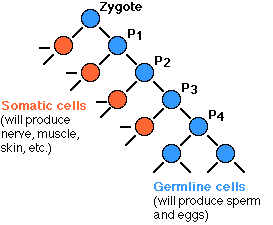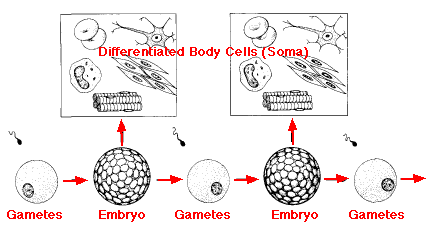Germline vs. Soma
Could a mutation in one of your liver cells ever be passed on to your children?
No!
Why not?
- The fusion of one sperm cell and one egg cell represents the only genetic link between the bodies of parents and the body of their child and
- the cells destined to produce sperm and eggs are set aside very early in embryonic life.
Example 1:
By the 15th week of gestation, the human female fetus has already set aside each and every cell that may someday develop into a mature egg. (In fact, each of these cells has already entered its final meiotic division!)
Caenorhabditis elegans is a microscopic (0.3 mm) nematode (roundworm) that normally lives in soil.
Like all animals, it starts life as a fertilized egg (zygote) which then undergoes the mitotic divisions needed to produce the
- 558 cells of the newly-hatched worm and, later,
- the 959 somatic cells, and a variable number of germ cells, of the adult worm.
Because - the worm is transparent and
- the pattern of differentiation is so rigid
it has been possible to trace the lineage of every single somatic cell in the animal.

It turns out that the fate of the 16 cells produced by the first 4 mitotic divisions of the zygote is completely predictable.
The zygote is, of course, totipotent. That means that it retains the potential to form all the cells - germline and somatic - of the animal.
At each of the first four mitotic divisions, one daughter cell (red) loses this totipotentiality and all her daughters will be restricted to forming the somatic tissues of the animal. The second daughter cell - shown in blue in the figure (P1, P2, P3, and P4) retains its totipotentiality.
At the 5th mitotic division, both daughter cells remain totipotent and go on, in due course, to form the sperm and eggs.
Weismann's Theory of the continuity of the germplasm
Over 100 years ago, the German biologist Weismann recognized that animals are made up of:
- body cells (somaplasm), which contain
- gamete-producing cells (germplasm).
At each generation, the embryo that develops from the zygote not only sets aside some germplasm for the next generation but also produces the cells that will develop into the body, the soma, of the organism.

| Today we know that only the germplasm - the gametes and the cells that form them - continue to express high levels of the enzyme
telomerase. These cells are able to maintain the length of their chromosomes forever and are immortal. The cells of the somaplasm, in contrast, stop producing telomerase, lose a portion of their chromosome tips at each mitosis, and eventually die. |
In Weismann's view, the somaplasm simply provides the housing for the germplasm, seeing to it that the germplasm is protected, nourished, and conveyed to the germplasm of the opposite sex to create the next generation. The old riddle about which came first, the chicken or the egg, would have been no puzzle to Weismann. In his view, the chicken is simply one egg's device for laying another egg.
Exceptions
The distinction between germline and soma exists only in animals.
In plants, cells destined to become gametes do arise from somatic tissues. In the flowering plants (angiosperms), for example, certain signals cause meristems that had been making stem tissue to become converted into flower buds which go on to make the gametes.
In microorganisms, all life's functions are embodied in a single cell. (However, some unicellular organisms, like the ciliated protozoan Tetrahymena, have a complete genome in their micronuclei, which are passed on to the next generation, as well as genes in a macronucleus, which is not. Thus, even here, there is the equivalent of a distinction between germline and soma.)
Somatic vs. Germline Mutations
The significance of mutations is profoundly influenced by the distinction between germline and soma. Mutations that occur in a somatic cell, in the bone marrow or liver for example, may
- damage the cell
- make the cell cancerous
- kill the cell
Whatever the effect, the ultimate fate of that somatic mutation is to disappear when the cell in which it occurred, or its owner, dies.
Germline mutations, in contrast, will be found in every cell descended from the zygote to which that mutant gamete contributed. If an adult is successfully produced, every one of its cells will contain the mutation. Included among these will be the next generation of gametes, so if the owner is able to become a parent, that mutation will pass down to yet another generation.
More than 8000 people living in South Africa today carry a gene for the metabolic disease called porphyria. Every one of them has acquired their gene through a chain of ancestors leading back to a single couple: Ariaantje Jacobs and Gerrit Jansz. This woman and man emigrated from Holland to South Africa late in the seventeenth century and one or the other of them passed the gene - through the germline - on to their descendants. Fortunately, the ailment is usually mild (unless the person is given a barbiturate sedative, which triggers a violent reaction).
Example 2:
Retinoblastoma, a tumor that occurs in humans in - a sporadic form, which is caused by a somatic mutation in each of the two RB genes in a cell
- a familial (inherited) form, which is caused by a somatic mutation to one RB gene in a cell that already has one mutant RB gene inherited through the germline from a parent.
Frequency of Germline Mutations
Children are some 16 times as likely to inherit a new RB mutation from their father than from their mother. This bias probably occurs with all germline mutations. Why?
A cell is at its greatest risk of acquiring new mutations when it is replicating its DNA during the S phase of the cell cycle. In humans, some 120 mutations (unrepaired errors in DNA replication) occur at each mitosis. (Fortunately, most of these occur in nonessential DNA).
Females:
Only 23 mitotic divisions occur from the fertilized egg that starts a little girl's embryonic development and the setting aside of her future eggs.
Males:
The sperm of a young (28 year-old) father is the descendant of at least 380 mitotic divisions since the fertilized egg that formed him. The ratio (380:23) is just about 16, the same ratio by which fathers are more likely than mothers to transmit newly formed mutations to their children. (But chromosomal aberrations, like aneuploidy, are more apt to arise in eggs than in sperm).
6 June 1999

